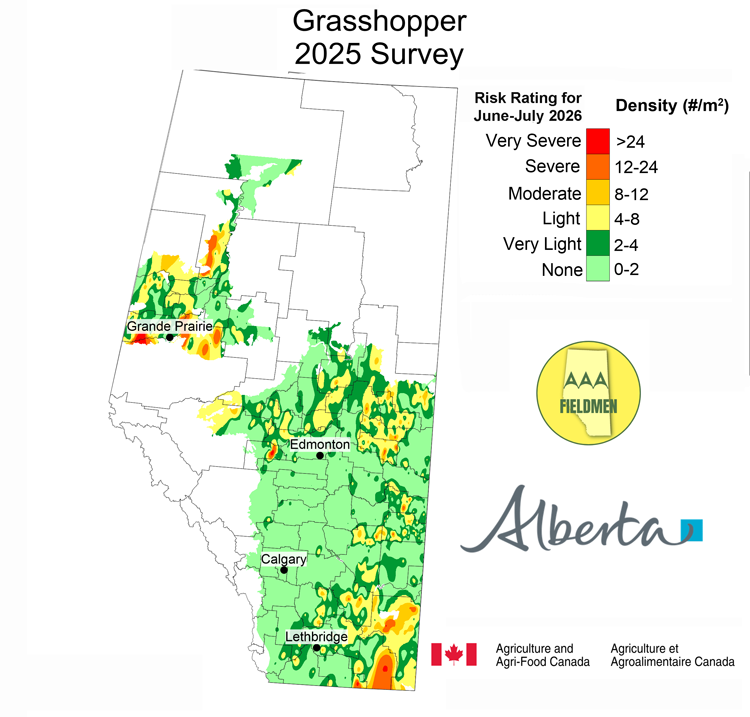Government mail service may be affected by the Canada Post labour disruption. Learn about how critical government mail will be handled.
Methodology
The 2025 grasshopper survey map is based on adult grasshoppers counts conducted in late July and August 2025 by the Agricultural Fieldmen of Alberta. A total of 2,195 fields were surveyed across the province in 2025.
The adult grasshopper counts give an indication of the number of individuals capable of reproduction and egg laying. Environmental factors can result in higher or lower actual populations than forecast. Individual producers need to be aware of the potential risks in their area and monitor fields accordingly and then make the appropriate decisions if control measures are required.
For information on identification, life cycle, damage and pest management, see Grasshoppers – Overview.
2025 survey findings
Peace River region and north central Alberta
In 2025 in the Peace region, there were hotspots with severe populations of grasshoppers. Results from the rest of the region were more moderate. The dominant species in 2025 was Bruner’s spur-throat grasshopper; however, clear-winged, 2-striped and red-legged grasshoppers were also common.
After evaluating years of grasshopper data, a trend has emerged that one species (Melanoplus bruneri, Bruner’s spur-throat grasshopper) in the Peace and northern crop-production areas seems to have a 2-year lifecycle. On the Alberta side of the Peace, odd years tend to have grasshopper numbers that can cause crop loss issues, while in the even years the numbers are low. If the pattern holds true, then Bruner’s grasshopper should not be an issue in the Peace and the northern crop production areas in 2026.
Bruner’s is not the only grasshopper in this region that can cause crop loss. There were areas that had high numbers of one-year lifecycle grasshoppers, like clear-winged. Scouting the roadsides and field edges in late May to early June is key to understanding possible grasshopper issues.
Grasshoppers were more of an issue in northern Alberta in 2025 than in 2024. Although generally, grasshopper numbers were low to moderate, with severe risk isolated to small pockets.
Southern Alberta
In 2025 in southern Alberta, grasshopper numbers were comparable to 2024, although populations were clustered in the eastern part of this region. Development was initially faster than average with warm May conditions but evened out later in the season.
September and October were generally warm and dry, ideal conditions for grasshopper egg laying and grasshopper egg development. The potential for outbreaks in the southern region and along the eastern border region in 2026 still exists.
Scouting roadsides and field edges in late May and June is vital to understanding grasshopper risk. This is especially important in areas with significant grasshopper risk.
On individual farms, particular attention should be paid to areas that traditionally have higher grasshopper populations. In addition, grasshoppers tend to lay their eggs near areas of green growth in the fall that will provide potential food sources for emerging young the following spring. Areas with early green plant growth such as field margins, fence-lines and roadsides are also areas that will give early indications of potential grasshopper problems.
Control measures
If insecticides are needed, note label precautions regarding user safety and proper application techniques and instructions to reduce impacts on non-target organisms. It is important to remember that control measures are intended to protect the crops from economic damage and are never successful in totally eliminating grasshopper populations. It is easier to scout and control grasshoppers earlier in their lifecycle rather than waiting until they are more mobile.
Acknowledgements
Thanks to all the Alberta Agricultural Fieldmen who complete this survey and the continuation of this important work.
Thanks to Jon Williams, Agriculture and Agri-Food Canada, Saskatoon, for producing the map.
Historical survey maps
- 2024 Survey Map
- 2023 Survey Map
- 2022 Survey Map
- 2021 Survey Map
- 2020 Survey Map
- 2019 Survey Map
- 2018 Survey Map
- 2017 Survey Map
- 2016 Survey Map
- 2015 Survey Map
- 2014 Survey Map
- 2013 Survey Map
- 2012 Survey Map
- 2011 Survey Map
- 2010 Survey Map
- 2009 Survey Map
- 2008 Survey Map
